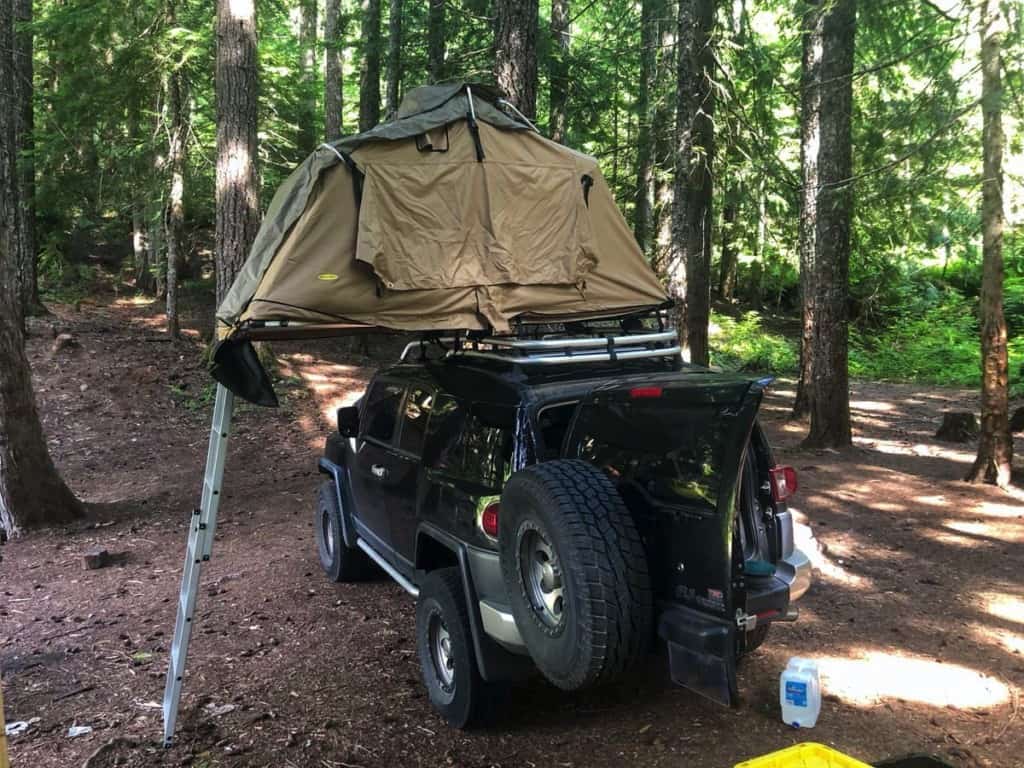
Camping in a roof top tent can be quite different from using an ordinary ground tent. It offers tons of benefits and a touch of luxury! After a few uses, I quickly noticed some tips I wish were shared with me when I first got started!
Here I will be sharing some of the things I discovered along the way while using my roof top tent (RTT). This will be helpful for people interested in buying a one and also for those who are new to roof top camping as well.
Make sure it fits your vehicle
This might seem like common knowledge but you would be surprised. By “fitting your vehicle”, I mean to take measurements of your car’s roof or truck bed and compare it to the size of the tent.
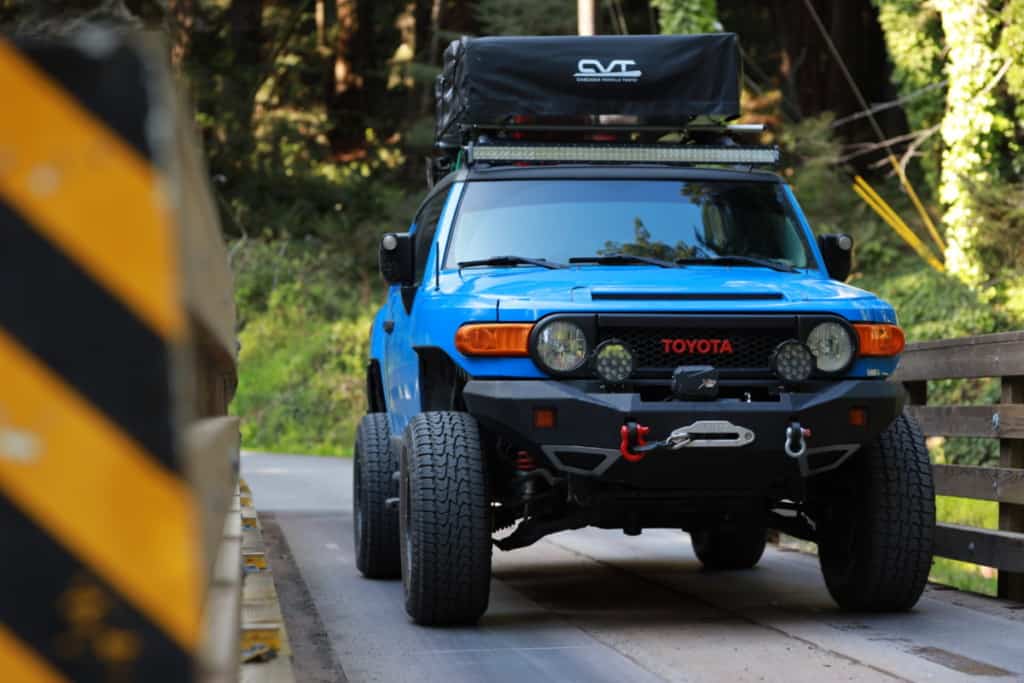
Many four-person RTTs are extremely large and will fit best on a full-size truck or full-size SUV. If you have a smaller vehicle, I would recommend sticking with a two-person tent for the smallest possible footprint.
When I first received our RTT, I was surprised how big it was and it’s only rated to fit 2.5 people! The point I am trying to make is you don’t want to front, back, or sides of the tent overhanging at any point on your vehicle.
Knowing weight limits
It is vitally important to understand what dynamic and static weight limits are and how they play a roll in your set up.
In order to safely use a RTT, it needs to be secured properly and not exceed any weight limit thresholds.
The last thing you want to happen is your brand new beautiful RTT to fly off your roof, possibly damaging your vehicle, rack, or others. To understand weight limits and the best practices, I would our article on Choosing a Rack System for a RTT.
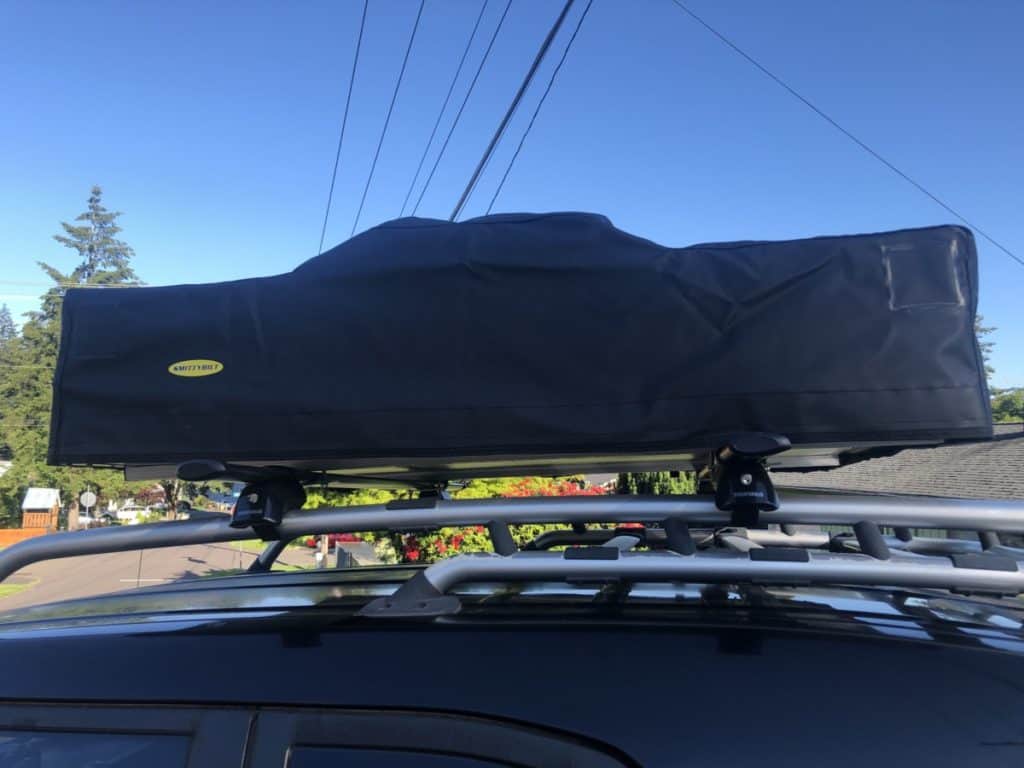
The beginning of the article gives an explanation of the weight limits and the rest of the post goes on to give examples of the best rack systems for RTTs.
Knowing the roof of your vehicle’s weight limit as well as your rack system will ensure safe travel on and off the road!
Do a test run
Before you go out to a campground or go on a dispersed camping adventure, give the RTT a test run in your driveway.
Open the tent, set up the ladder, get inside the tent, open the zippers, set up canopies, and then pack it back it. Doing this will just give you a good feeling of how the tent works and if there are any other accommodations you need.
I would say this is especially true for dog owners. I have a 60-pound Shephard mix and our tent sits over 8-feet in the air. Now, me being a young-strong guy, I figured I could just muscle him up there.
Well, long story short that wasn’t the case and we had to get creative. You can check out our Youtube channel and you will see how I have to get him into the RTT.
Opening the tent up in your driveway will give you plenty of time to figure out a system that works best for you. If you encounter any problems, it is better to be at home than in the middle of the woods!
Water it down before using
I wish more people shared this tip because for long time campers it is common knowledge, but to newbies there isn’t really a way to find out.
Open your tent and give it a good spray with water before ever using it. This actually helps the stitching in the fabric form a tighter bond which will help its waterproof ability! Just be sure to let the tent dry completely before packing it away.
This simple step is free, takes very little effort, and makes a difference in my opinion! If you’re concerned with the tent’s ability to stay waterproof, I recommend spraying it with Fabric Guard every so often to maintain and improve its waterproof coating.
While on the topic of waterproofing, this seg ways nicely into my next tip for RTT users.
Pack the tent dry
If at all possible, try not to pack your RTT when it is wet. This will lead to mildew that begins to germinate in just 24-48 hours. Once the mildew takes hold, it is nearly impossible to expunge.
The mildew will form between the fabric in your tent leaving dark spots and an unbearable smell along with it. If you have to pack your tent up when it is wet or damp, be sure to air it out first thing when you get home.
Ventilate your tent
It’s a frequent occasion to wake up to a wet tent by having condensation buildup on it overnight. It will form on your tent as well as under your mattress pad inside.
This is actually a much bigger problem than I realized and I see numerous RTT owners posting questions on Facebook groups on how to remedy the issue.
The best thing you can do to try and counter this problem is by properly ventilating the tent. Opening one, two, or all of the windows will help the airflow dramatically.
There are many other steps you can do to stop condensation inside your RTT. Read our full guide on How To Stop Condensation in a RTT! This will layout many ideas and tips so you won’t have to worry about condensation ever again.
The last thing you want to do is wake up wet or damage your RTT permanently when you pack it away.
Ladder-type and setup
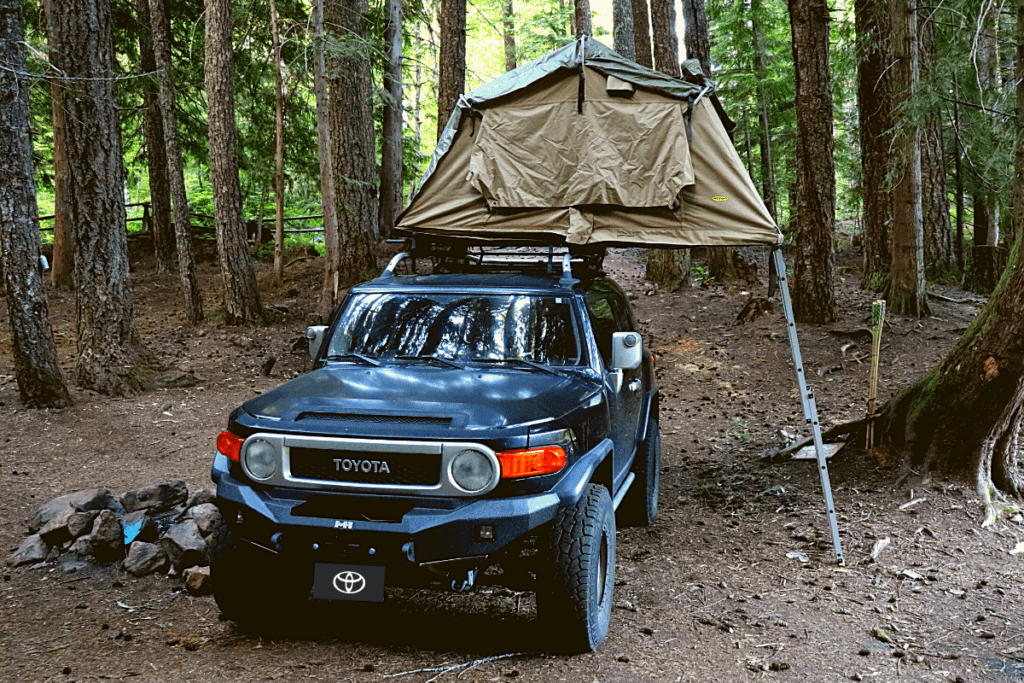
If you have a choice, I would highly recommend opting for a telescoping ladder. I cannot emphasize this enough!
The other option would be a sliding ladder, which is plenty strong in terms of the weight it can hold. However, the sliding tracks are a total pain in the butt to get open. Then, the tracks will accumulate dirt and dust which makes the tracks increasingly more difficult to open.
With a sliding ladder, you are also forced to fit the two pins perfectly into the predrilled holes when you set up the ladder. Whereas a telescoping ladder can be retracted and extended to the exact length you prefer.
Another tip for your ladder is to simply set it up properly. Some people angle it either too steep or too gradual. Aim to have the ladder at about an 80° angle.
Level your vehicle
This step is one that shouldn’t be ignored. Hopefully I’ll save you a headache because this lesson only takes one time to learn from.
Leveling your vehicle is extremely important because the slightest slant inside the RTT is very noticeable. You don’t want to be rolling around inside the tent or have to repark your vehicle after getting camp set up.
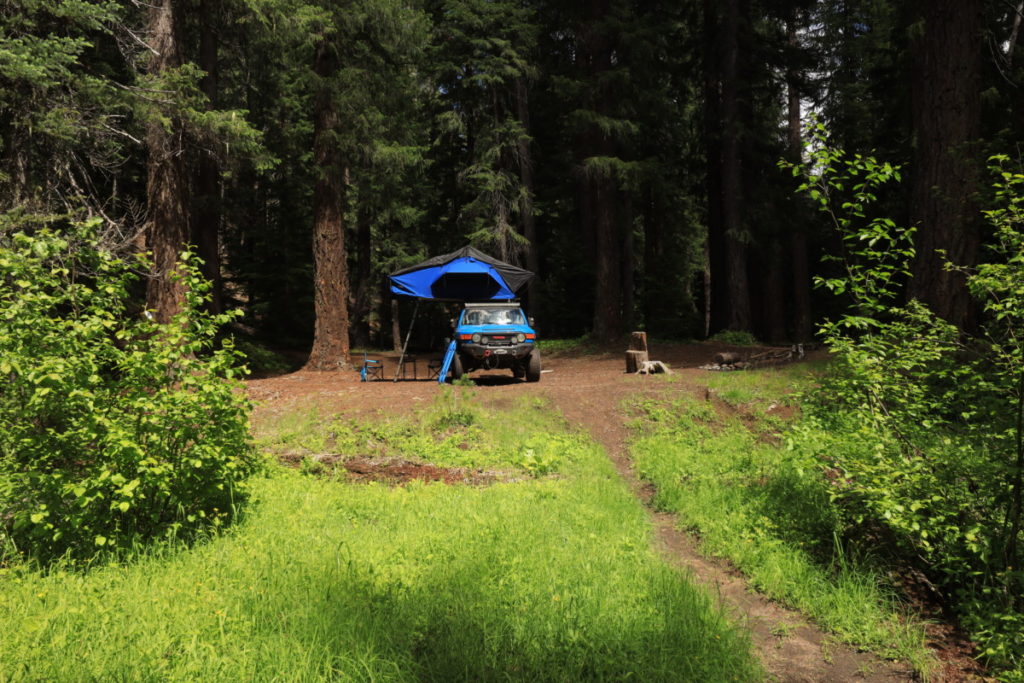
You can use 2×4’s, recovery boards, or rocks to help level you vehicle as best as possible. This may take you a few extra minutes now and again, but it is way faster than having to readjust your parking spot after opening your tent.
Having a height advantage while packing the tent
If you have a hardshell RTT, you can pretty much skip this step since the set up process is so easy on those models.
However, for softshell RTTs, if you’re short or have a very tall vehicle, packing and opening your tent becomes quiet the event.
Our vehicle sits very high compared to most vehicles. I am six feet tall and have a heck of a time undoing the sliding ladder and tucking the fabric into the sides of the tent.
I recommend either bringing a stool or getting right on top of the roof. This will speed up the break down process of your RTT and make it less of a workout!
Clean your tent frequently
I love RTTs because they stay WAY more clean the a ground tent. You don’t have to lay it down in the mud and dirt doesn’t get tracked in near as easily.
It is still important to air out your tent and rinse it down every so often to keep it fresh and avoid dirt build up.
Here is our Complete Step-By-Step Guide to Cleaning a RTT! This article will detail all of the little things you can do to get the most out of your tent for years to come.
Make your bedding more comfortable
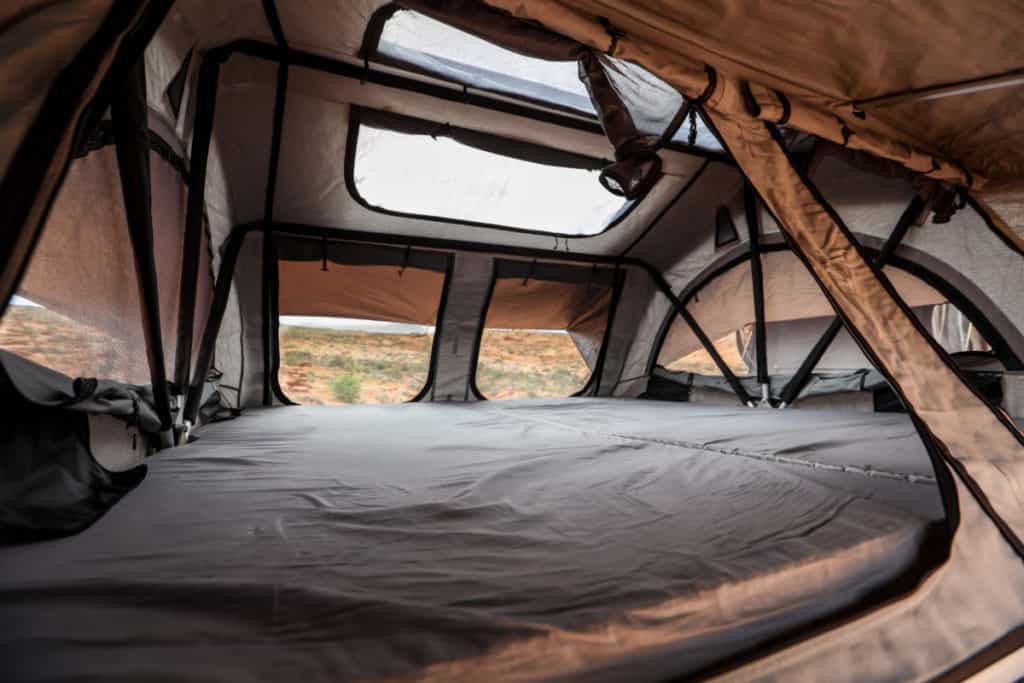
Again, RTTs are very comfortable because of the flat surface and cushy mattress pad. However, by completing a couple of additions you can make your tent far more comfortable than it already is!
You can add a mattress topper for a thicker pad between you and the floor. If you sleep on your side, you can sometimes feel the floor of the tent on your hip. So I would recommend adding a mattress topper, however, keep it down to just two inches thick.
If you go any thicker than that, the tent will likely not close all of the way and you will have to take the topper out after each use.
The type of bedding you put in your tent matters as well. For a more detailed guide on how you can do that, take a look at our post on How To Make Your Bedding More Comfortable.
Find ways to mitigate fuel consumption
One of the first things you will notice after mounting the RTT to your vehicle is the added weight it tacks on. You will feel the drive of your car slightly affected and maybe a difference in how it drives on the highway too.
For the most part, you can drive as you normally would. However, the major side effect of having a RTT is the added wind resistance and drag it produces as you drive.
This will likely cause your fuel economy to drop by one or two miles per gallon, maybe more depending on your vehicle. This will add up over time.
Fortunately, there are a handful of things you can do to mitigate your fuel loss! I provide tons of examples and helpful ideas in another article, 8 Tips To Prevent Fuel Loss with a RTT!
Minimize entry costs
To some people, this tip may be intuitive. But for many, it may not be. Lower the amount you spend on your first RTT as best you can!
These fun toys are expensive, but there are plenty of solid models below or around the $1,000 mark. If you are unsure if you will enjoy using a RTT and all of the pros and cons that come with it, then I recommend opting for a more cost-effective model.
You would hate to spend $4,000 on a gorgeous hard shell RTT, only to find you used it a few times and didn’t care for it much. If you have already bought a RTT and are looking to upgrade or sell it, don’t worry!
Selling used RTTs is very common and you can recoup a fair chunk of the money you spent on it originally. I would recommend Facebook marketplace and different Facebook groups for selling or buying a used one.
When I first got started, I spent a total of $1,450 on my RTT and rack system bought and delivered to my door. That is an insanely low cost compared to what I could have spent.
This will give you peace of mind knowing if you find it isn’t for you, then you didn’t lose or waste a lot of money in the first place.
Recommended Gear
After camping for so many years, I have been able to taste a wide range of equipment and see what works best for me.
Check out our Recommended Gear page to see all of the gear I use and personally suggest to friends and family!
Wrapping Up
Those are all of the tips I would share with any newcomer that just got a RTT. I tried my best to leave the obvious ones out and showcase some unique insights I came across since using mine.
For the most part, RTTs are quite simple but do require a fair base of knowledge just so you’re safe and don’t damage the tent.
If you have any other questions, check out our Youtube channel and also the Beginner Info page. I have a huge bank of information made specifically for people just getting started in their RTT journey as well as some more advanced stuff too!
